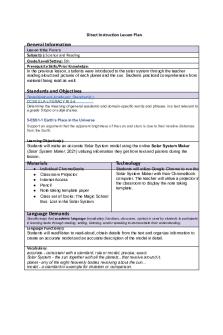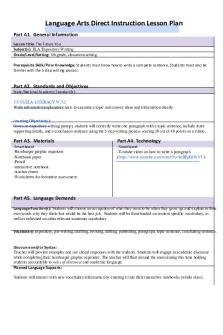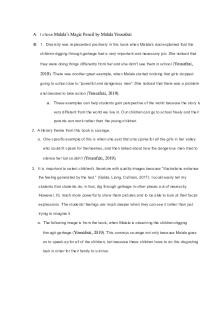C970 Lesson - Task 1 PDF

| Title | C970 Lesson - Task 1 |
|---|---|
| Course | Children's Literature |
| Institution | Western Governors University |
| Pages | 15 |
| File Size | 617.2 KB |
| File Type | |
| Total Downloads | 27 |
| Total Views | 187 |
Summary
Task 1 ...
Description
CHILDREN’S LITERATURE TASK 1
Name: Student ID: Date: 09/2/2020 Course: C970 Children’s Literature PART A: SELECTED ILLUSTRATED BOOK WITH POSITIVE DIVERSE REPRESENTATION FOR PART B DISCUSSION & PART C LESSON PLAN
● The Day You Begin by: Jacqueline Woodson
PART B
Part B1-B1a: Positive Diverse Representation The Day You Begin is a book that celebrates diversity, and encourages inclusion. This book beautifully highlights the characters’ differences, and provides readers something to relate to. A specific example of diversity and inclusion can be seen in the following passage, “There will be times when you walk int a room and there is no one quite like you. Maybe it is your skin, your clothes, or the curl of your hair (Woodson, 2018)”. This powerful quote explains that everyone is different, and that is okay. There will be times that you feel alone and different, but that does not make you any less special. Differences are to be celebrated. Additionally, our diversity provides everyone with a chance to expand our own knowledge, understanding and appreciation of the world. Finally, this book encourages children to believe in the value of their own backgrounds.
Part B2-B2a: Literary Theme & Literary Element: Acceptance of Self and Others A major theme that The Day You Begin focuses on is: acceptance of self and others. This lesson is significant for children because it also promotes other positive character traits such as; kindness, empathy, and appreciation. In the beginning of the book, the main character feels left out and alone because she is different from the other children in the classroom. It is not until she realizes that everyone else has something that makes them unique, that she feels self-acceptance and included. The theme acceptance of self and others can be seen in the quote, “And all at once
in a room where no one else is quite like you, the world opens itself up to make some space for you (Woodson, 2018)”. This quote exemplifies acceptance, because it celebrates everyone’s differences, and says that there is a place in the world for all of our quirks and differences. A literary element that supports the theme of acceptance is the overall plot of the story. The main character starts out as apprehensive and feeling excluded because of her differences, but as the story continues, she realizes that we all have something about us that makes us unique.
Part B3: Quality Illustrations in Selection of Children’s Literature According to research, illustrations in story books are meant to supplement the story with images that the text does not show. The text and the illustrations each tell their own part of the story. The illustrations and the text combined, however, supply the reader with the entire story (Galda et al, 2017). Pictures may extend the words (Galda et al, 2017)). This is shown in the story, The Day You Begin. In this book, the illustrations highlight the physical diversity of the characters that the text introduces. The reader is able to make those connections, and are able to understand the story more deeply. Additionally, quality illustrations can foster imagination and creativity for young readers (Amelia Book Company, n.d.). Children are exposed to more art via illustrated stories, and can appreciate more artistic styles based on their use in specific books.
Part B3a: Quality Illustrations & Literary Theme
(Woodson, 2018) This illustration found in The Day You Begin conveys the theme because it illustrates acceptance of self and others. The children seen in
the illustration are of different ethnicities and cultures. Yet, here they happily lay together. The main character (top left) is smiling to herself, which shows acceptance of self. The illustration depicts acceptance of others because the children are able to play together harmoniously.
Part B4-B4a: Genre & Genre Characteristics The genre of the book The Day You Begin, is realistic fiction. Realistic fiction is defined as stories that could conceivably occur in the real world (Galda et al, 2017). Two characteristics of realistic fiction is: plausible plots and characters. A plausible plot means that it is a realistic reflection of issues in the world (Galda et al, 2017). This characteristic is exemplified in the story because children are often insecure of their quirks, and may feel excluded because of them. In the beginning, we clearly see that the main character is nervous and feels left out at school because of her differences. The second characteristic, characters, is also exemplified in this story. All of the characters in this story are very diverse from one another. They travel to different places, eat different foods, and speak differently. Classrooms in the world are also made up of diverse students, just like in the book.
PART C. Direct Instruction Lesson Plan Develop a lesson plan to teach analysis of literary theme. Your lesson plan must meet the following criteria: ● must use your chosen children’s book identified in part A ● must teach analysis of literary theme ● must use the “Direct Instruction Lesson Plan Template” Direct Instruction Lesson Plan Template
General Information
Lesson Title: Acceptance as a Theme
Subject(s): Children’s Literature
Grade/Level/Setting: 3rd grade
Prerequisite Skills/Prior Knowledge: Students must be able to write legibly and spell within reason Students must be able to hold a pencil well enough to draw and color.
Standards and Objectives
CCSS.ELA-LITERACY.RL.3.2: Recount stories, including fables, folktales, and myths from diverse cultures; determine the central message, lesson, or moral and explain how it is conveyed through key details in the text (Common Core State Standards Initiative, n.d.).
Learning Objective(s): After reading The Day You Begin, students will be able to determine the theme of a story, and create a Comic Strip Book Response that provides evidence to support the theme with a proficiency of 17/20 on the provided rubric.
Materials
Technology
YouTube video will be used for a read-aloud Laptop & projector to play YouTube of book The Day You Begin by Jacqueline video (Brightly Storytime, 2018) Woodson (Brightly Storytime, 2018) Reading Journals Pencils Link: https://www.youtube.com/watch?v= Glue Coloring utensils (crayons, colored XUkWoRpeR4 pencils, markers) Theme Graphic organizer (Kiser, n.d.)to be glued into reading journal Comic Strip Book Response
Worksheet (The Literacy Loft, n.d.)copy per student, with a few extras Comic Strip Rubric (Marvelous Miss G, n.d.) Claim and evidence poster (Faber, 2015) World Wall ELL Flashcards The Day You Begin by Jacqueline Woodson (Woodson, 2018)
Language Demands
Language Function(s): Students will determine the theme of the story, and provide evidence to support their claim.
Vocabulary: Theme: Moral or message in a story Diversity Acceptance
Discourse and/or Syntax: Students will discuss the definition of ‘theme’, and how to determine a theme of a story by providing text evidence. Additionally, the teacher will float around and observe students to provide scaffolding and further supports where needed. In order to demonstrate individual mastery of the objective, students will create their own comic strips and answer text-based questions.
Planned Language Supports: Word wall of common theme topics (to be created during whole class discussion) Claim & Evidence poster (Faber, 2015) ELL Flashcards
Instructional Strategies and Learning Tasks
Anticipatory Set:
Activity Description/Teacher
Student Actions
Teacher will introduce the topic by asking the class to recall their favorite common story (ex: The Boy Who Cried Wolf, Three Little Pigs, etc.) Run through a quick summary of the story, then ask the students what they think the point of the story is This is to activate previous knowledge of summary, and inferring main idea of story Segway into presentation procedures of new information
Students will actively listen and participate in the discussion as needed
Presentation Procedures for New Information and/or Modeling:
Activity Description/Teacher
The purpose of this lesson is to teach students the definition of ‘theme’, and how to determine the theme of a story Teacher will ask students to take out the reading journals Teacher will lead a discussion on the topic of story themes Theme definition: the message, moral, or meaning of a story. Teacher will tell children that the themes are messages from the author that are not typically clearly stated, but are to be determined or inferred by the reader (Ex: the theme of Three Little Pigs is that taking more time to do things correctly, pays off in
Student Actions Students will take out their reading journals Students will actively listen and participate in whole-class discussion led by teacher. Students will take notes on theme in their reading journals, and answer reflective questions aloud and in their reading journals Students will engage and provide input during the completion of the World Wall In their reading journals, the sentence starter will be provided by teacher: “I know the theme is ____ because the text says ____” as a guide for the future.
Students will write predictions in their journals
Students will quietly watch YouTube (Brightly Storytime, 2018)
the end) Teacher will create a Word Wall with students help about common themes found in stories (courage, acceptance, dreams, kindness, empathy, love, family, etc.) (During this whole class discussion- the teacher will ask reflective questions, “What did the characters learn? and “How did the characters change?”) Teacher will direct students’ attention to the Claim & Evidence poster (Faber, 2015) Teacher will provide an additional sentence starter for students to copy into their reading journals as a guide for future use Teacher introduce The Day You Begin by Jacqueline Woodson, and ask students to predict the plot and theme of the story in their journals Teacher will play YouTube video (Brightly Storytime, 2018) Link: https://www.youtube.com/watc h?v=-XUkWoRpeR4
Guided Practice:
Activity Description/Teacher
Teacher will ask students to determine the theme of the provided YouTube video (Brightly Storytime, 2018)
Student Actions Students will quietly watch provided YouTube video (Brightly Storytime, 2018) Students will engage in whole-class discussion led by teacher, and providing input when asked Students will take notes in their reading journals
during a whole class discussion Teacher will pass around hard copy of The Day You Begin (Woodson, 2018) Teacher will pass out Theme Graphic organizer (Kiser, n.d.) to each student Teacher will use guided practice as an opportunity to analyze story for theme with the students, and fill out ONE of the text-based evidence sides on the graphic organizer (Kiser, n.d.) (Ask: What is the theme of this story? How do you know that? What specific lines from the book led you think that? Theme: Acceptance of Self, and Others) Teacher will ask students to pair up with a partner in order to fill out the second text-based evidence side on graphic organizer (Kiser, n.d.) Teacher will float around and observe students to provide scaffolding and further supports where needed.
Students will be able to refer back to book, if necessary Students will work with a partner to provide text-based evidence from The Day You Begin used to determine the theme of Acceptance of Self, and Others
Students will take part in Think Pair Share with whole class discussion, and reflect on their work with their partner (any questions/concerns)
After 10-15 minutes, teacher will lead a reflective (Think Pair Share) whole class discussion about the text-based evidence students used in their graphic organizers
Independent Student Practice:
Activity Description/Teacher
Teacher will pass out Comic Strip Book Response Worksheet (The Literacy Loft, n.d.) Teacher will provide a copy of the rubric on the projector screen Teacher will provide students instructions based on rubric (Marvelous Miss G, n.d.), and answer any remaining questions
Student Actions
Students will acquire materials needed for this activity (coloring utensils, pencils) Students will listen to teacher as she explains the instructions and goes over the provided rubric (Marvelous Miss G, n.d.) Students will first quietly answer book response questions on the worksheet, then will create a Comic Strip.
Students will demonstrate their individual knowledge of theme analysis and comprehension through this activity
Culminating or Closing Procedure/Activity:
Activity Description/Teacher
This reflective activity will focus on the specific theme of Acceptance of Self and Others Teacher will ask students to take out their reading journals Teacher will ask the students to make Text-to-Self connections (Name a time you felt nervous or insecure? What helped you feel more comfortable? What is something that is unique about you or your family?) Teacher will collect reading journals as a formative assessment
Student Actions
Students will reflect in their reading journals by making Text-to-Self connections
Differentiated Instruction
Gifted and Talented: -
-
These students will be challenged by using new vocabulary words in their comic strip, and more complex sentence structure on their book response questions (or in their reading journal). This supports these students because their creativity is being challenged, and encouraged to explore a higher order of thinking.
EL: Word Wall will help ELL students understand and recall common topics used in this lesson plan ELL Flashcards will also include repeated words and phrases in student’s native language to provide language scaffolding, and improve overall comprehension.
Students with Other Special Needs: ADHD: In addition to seating chart specifications, both of these students will be provided extra time on the Independent Practice, as it is quite labor intensive (writing, drawing, and coloring).
Assessment
Formative These assessments will take place during all whole-class discussions to assess students’ individual comprehension levels, and decide where additional supports/scaffolding should occur. This is done prior to independent practice, so that the students have a deeper understanding of the lesson before demonstrating mastery. Teacher will also use reading journals collected at end of day to clarify that students’ have fully grasped topic, or if it needs to be revisited/rephrased.
Summative Teacher will utilize the Comic Strip Rubric to assess students’ independent practice activity. Teacher will know that students have met the objective when: students are able to determine the theme of a story, and create a Comic Strip Book Response that provides evidence to support the theme with a proficiency of 17/20 on the provided rubric.
D. References Amelia Book Company (Ed.). (n.d., February). Why Are Children’s Books Illustrations Important for Young Readers. Retrieved September 03, 2020, from https://ameliabookcompany.com/childrens-books-illustrations/
Brightly Storytime (Director). (2018, October 3). The Day You Begin - Read Aloud Picture Book | Brightly Storytime [Video file]. Retrieved September 3, 2020, from https://www.youtube.com/watch?v=-XUkWoRpeR4
Common Core State Standards Initiative (Ed.). (n.d.). English Language Arts Standards " Reading:
Literature " Grade 3. Retrieved September 04, 2020, from http://www.corestandards.org/ELA-Literacy/RL/3/
Faber, J. (2015, June 15). Volcanoes - Helpful or Harmful? Prove it! Retrieved September 08, 2020, from https://betterlesson.com/lesson/635805/volcanoes-helpful-or-harmful-prove-it
Galda, L., Liang, L. A., & Cullinan, B. E. (2017). Literature and the child (9th ed.). Wadsworth Cengage
Kiser, H. (n.d.). Graphic Organizer Digital Resource. Retrieved September 04, 2020, from https://teachersherpa.com/template/Graphic-Organizer-Digital-Resource/a0ce45d4-7c3f4005-a43f-7796d8190a89/details?authorName=Hillary%20Kiser&afmc=f73e1705-476d4d01-83cd-2f5dd1c292bf
The Literacy Loft. (n.d.). Comic Strip Book Response. Retrieved September 04, 2020, from https://www.teacherspayteachers.com/Product/Comic-Strip-Book-Response-1791842
Marvelous Miss G. (n.d.). Comic Strip Rubric. Retrieved September 04, 2020, from https://www.teacherspayteachers.com/Product/Comic-Strip-Rubric-3608077
Woodson, J. (2018). The Day You Begin. New York, NY: Nancy Paulsen Books....
Similar Free PDFs

C970 Lesson - Task 1
- 15 Pages

Task 1 - Lesson Plan
- 6 Pages

Task 1 - Lesson Plan
- 8 Pages

Lesson Plan task 1
- 6 Pages

BDM2 Task 1 lesson plan
- 15 Pages

Unit 1 Task 1 Lesson 3
- 2 Pages

Unit 8 Task 1 Lesson 1
- 2 Pages

Lesson Plan / task
- 7 Pages

Lesson Plan - - Task 2
- 7 Pages

Task 1 Math Tools lesson plan
- 13 Pages

C732 Task 1 Lesson Plan - Passed
- 6 Pages

HXM1 Task 1 pdf - lesson plan
- 5 Pages

C365 Lesson Plan Task 1.docx
- 8 Pages
Popular Institutions
- Tinajero National High School - Annex
- Politeknik Caltex Riau
- Yokohama City University
- SGT University
- University of Al-Qadisiyah
- Divine Word College of Vigan
- Techniek College Rotterdam
- Universidade de Santiago
- Universiti Teknologi MARA Cawangan Johor Kampus Pasir Gudang
- Poltekkes Kemenkes Yogyakarta
- Baguio City National High School
- Colegio san marcos
- preparatoria uno
- Centro de Bachillerato Tecnológico Industrial y de Servicios No. 107
- Dalian Maritime University
- Quang Trung Secondary School
- Colegio Tecnológico en Informática
- Corporación Regional de Educación Superior
- Grupo CEDVA
- Dar Al Uloom University
- Centro de Estudios Preuniversitarios de la Universidad Nacional de Ingeniería
- 上智大学
- Aakash International School, Nuna Majara
- San Felipe Neri Catholic School
- Kang Chiao International School - New Taipei City
- Misamis Occidental National High School
- Institución Educativa Escuela Normal Juan Ladrilleros
- Kolehiyo ng Pantukan
- Batanes State College
- Instituto Continental
- Sekolah Menengah Kejuruan Kesehatan Kaltara (Tarakan)
- Colegio de La Inmaculada Concepcion - Cebu


